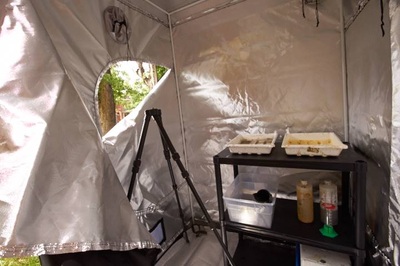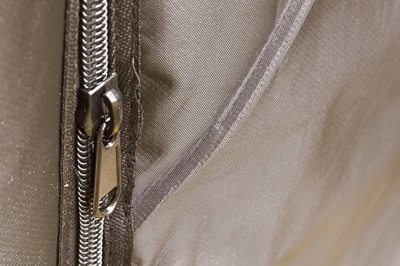|
I found a lightproof (mostly) darkroom tent that I'm using as version 2 of my camera/darkroom combo for shooting wet plate photography. The tent is actually a grow tent for plants, so it has a reflective interior to maximize light inside. It will also help my red darkroom light be brighter inside the tent when it's on. It's also much easier to carry and much more compact, 4' x 4' x 6' instead of 10' x 10' x 8' like may last tent was. It's also about 35lbs where my last one was much, much more and impossible to fit in my small sedan. I actually got the idea for using this tent here: http://contrastique.files.wordpress.com/2011/04/tent.jpg where there is also a picture of his tent on a bicycle trailer, ready to move. The extra bars for hanging grow lights can also be used to hang a red lightbulb, but I've also seem people online just cover their windows/ vents with red acrylic or gels to allow the natural light to illuminate the inside. I'll have to experiment. I found a small shelf from Home Depot for $26, it's a 4-tier plastic shelf (only three tiers used below) and it holds two trays for developing 8x10 plates well. It's Home Depot's (I think) HDX brand. I've decided to just use a tripod for ease of transport rather than the more cumbersome 2x4 plank setup in my version two plans at the bottom of this post. The small vent in the bottom are where I'm going to cover with some red plastic sheeting to make the light safe for working with the undeveloped silver in the collodion plates. Now I'm using a red bulb which I could hang from a hanging support (not pictured in any of these, I left it off when I set it up this time) but I'd rather eliminate the need to run a cord into the tent to plug the light in and the need for another power source besides my strobe batteries. Whether my strobes have enough power is still TBD... The best part! Okay not the best part, but it's SO nice not to have zippers and not have to crawl under the multiple layer of plastic to get in and out of the tent. The zipper is only on the outside, so you have to reach through, but the zippers seem pretty rugged and will hopefully not fail any time soon. Well that's the new tent, I'm pretty excited for a much easier to transport, quicker to setup, and much nicer looking tent to shoot tintypes from. Another option, more expensive but vital if high winds are an issue, is an ice fishing tent. I've seen one of these used, a small one with two rooms, one for the camera and one for the developing table. It's definitely nicer, but a little larger and at least 3x more expensive. Maybe I'll go that route in the future for some large plates shot outdoors, but for now this will work just fine, even for large plates. I purchased this tent for just over $100, and the quality of it is better than I expected. There wasn't even a brand name on the tent or paperwork (one sheet that was simple set up instructions, BTW setup of the poles is easy and they're numbered). I had seen brand names sewn onto other tents online but I think the same manufacturer makes them all and then people use their own brand patches. If you want one, just search "48x48x72 mylar darkroom tent" and you'll get a lot of results. If you have time to wait you'll be able to find them on sale. Pictures shot with the camera? If I build it this weekend, hopefully I can shoot some plates on Monday.
2 Comments
Nicole
7/20/2015 03:11:26
Hi - we are looking for such a tent to put in the basement so we can use the space as a darkroom without doing any construction. We have a lot of space and don't need it to be portable, so looking for the biggest tent we can find. Do you have details on the larger one you had been using?
Reply
7/20/2015 16:51:35
The larger tent is one I made by covering an expandable tent frame (search amazon 'canopy tent 12x12') that I borrowed with plastic sheeting from home depot, I think I used 3mil sheeting because it was cheapest, but I ended up having to use a second layer for the side of the tent that was in direct sun. In the basement you would not need two layers, though I would still turn off all lights in the basement while you're using the darkroom, especially if it's for silver process, the plastic sheeting may get pinholes over time and light may bleed though depending how close the artificial light sources are. The roof of the canopy tent frame is pretty tall so it may not work for the basement. A good way around this would be to do a tiny bit of construction and build the frame with 2x4's and cover it in black plastic sheeting. People also use light proof fabric which I would have preferred but is more expensive (amazon 'Blackout Roclon Fabric ,Three Pass Blackout Drapery Lining, 54" Wide'). I found a '120x120x78in/10x10x6.5ft Xlarge Non-toxic 600D Mylar Reflective Grow Tent Hydroponic Dark Room Box Hut' on amazon, but it's reflective-lined like all hydroponic grow tents so it's going to magnify all light inside. If you're in the basement and can make the room mostly light free then that shouldn't be as big of an issue, but if I were making a darkroom for silver process I wouldn't pay $400 for a reflective lined tent, I'd build a simple frame with 2x4's and cover with fabric or sheeting. The nicest thing about the hydroponic grow tents is the doors zip shut, however it sounds like you have the space in the basement and can just make a darkroom entrance with two 90 degree angles to block light and then you can avoid having to close the door at all. The space in the 12x12 tent was great for having ample room to work. Good luck with your darkroom! If you get it up post a link to photos if you put any up, I'd love to see what you figure out.
Reply
Leave a Reply. |
Jake BelvinI'm a photographer and film maker traveling in Southeast Asia for the first part of 2016. Archives
March 2016
Categories
All
|














